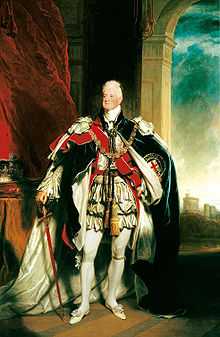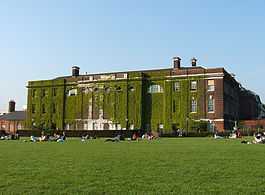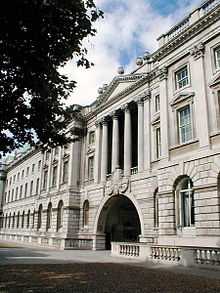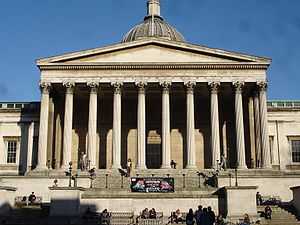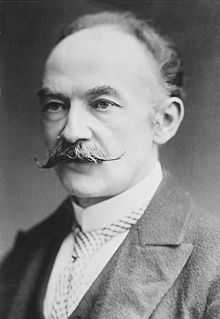University of London
| University of London | ||||||||||||
|---|---|---|---|---|---|---|---|---|---|---|---|---|
|
University of London Coat of Arms | ||||||||||||
| Latin: Universitas Londiniensis | ||||||||||||
| Established | 1836 | |||||||||||
| Type | Public | |||||||||||
| Chancellor | HRH The Princess Royal | |||||||||||
| Vice-Chancellor | Sir Adrian Smith | |||||||||||
| Visitor |
The Rt Hon Nicholas Clegg Lord President of the Council | |||||||||||
| Students |
135,090 internal (2005–2006)[1] 50,000 International Programmes[2] | |||||||||||
| Location |
London, England, United Kingdom 51°31′16″N 0°07′44″W / 51.52111°N 0.12889°WCoordinates: 51°31′16″N 0°07′44″W / 51.52111°N 0.12889°W | |||||||||||
| Colours |
| |||||||||||
| Website | london.ac.uk | |||||||||||
 | ||||||||||||
The University of London (informally referred to as London University) is a collegiate research university located in London, England, consisting of 18 constituent colleges, 10 research institutes and a number of central bodies.[3]
London is the second largest university by number of full-time students in the United Kingdom, with around 135,000 campus-based students and over 50,000 distance learning students in the University of London International Programmes. The university was established by Royal Charter in 1836, which brought together in federation London University (now University College London) and King's College (now King's College London).
For most practical purposes, ranging from admissions to funding, the constituent colleges operate on a semi-independent basis, with some recently obtaining the power to award their own degrees whilst remaining in the federal university. The ten largest colleges of the university are King's College London; University College London; Birkbeck; Goldsmiths; the London Business School; Queen Mary; Royal Holloway; SOAS; and the London School of Economics and Political Science. The specialist colleges of the university include Heythrop College, specialising in philosophy and theology, and St George's, specialising in medicine. Imperial College London was formerly a member before it left the University of London in 2007.
Many notable individuals have passed through the University of London, either as staff or students, including at least 4 monarchs, 52 presidents or prime ministers, 74 Nobel laureates, 6 Grammy winners, 2 Oscar winners and 3 Olympic gold medalists.
In post-nominals, the University of London is commonly abbreviated as Lond. or, more rarely, Londin., from the Latin Universitas Londiniensis after their degree abbreviations.
History
19th century
Founded in 1836, the university at first comprised just two colleges: University College, which previously had no official chartered status and did not apply religious tests to its students, and King's College, which had been chartered since 1829 and which admitted only members of the Church of England. Both King's (founded 1829) and University College London (founded 1826) pre-date the University of London, which initially served solely as an examining body for the constituent colleges.
In 1858, the university expanded its role by offering the University of London International Programmes to candidates outside of the colleges, the first of its kind in the country. A new headquarters at 6 Burlington Gardens, providing the university with exam halls and offices, was built to accommodate the new role. In 1878, the University set another first when it became the first university in the UK to admit women on equal terms with men. Four female students obtained Bachelor of Arts degrees in 1880 and two obtained Bachelor of Science degrees in 1881, again the first in the country.[4]
In 1898, in part as a response to criticisms of universities which merely served as centres for the administration of tests, and calls for research and education to be more central functions of universities, the first University of London Act was passed, reforming the university and giving it responsibility for monitoring course content and academic standards within its institutions. The monitoring was conducted through newly formed centralised faculties and Boards of Studies, and King's and UCL now became constituent parts of the University of London. A symbolic element to the new centralisation of the university was the fact that UCL property became property of the University of London.[5] This significant expansion of role meant the University again needed more space, and so 6 Burlington Gardens was vacated in 1899.
|
20th century
Shortly after 6 Burlington Gardens was vacated, the university went through a period of rapid expansion. Bedford College, Royal Holloway and the London School of Economics all joined in 1900; Regent's Park College, which had affiliated in 1841, became an official divinity school of the university in 1901; Goldsmiths College joined in 1904; Imperial College was founded in 1907; Queen Mary College joined in 1915; the School of Oriental and African Studies was founded in 1916; and Birkbeck College, which was founded in 1823, joined in 1920. This rapid expansion meant that the University's new premises would prove insufficient by the 1920s, requiring yet another move. A large parcel of land in Bloomsbury near the British Museum was acquired from the Duke of Bedford and Charles Holden was appointed architect with the instruction to create a building "not to suggest a passing fashion inappropriate to buildings which will house an institution of so permanent a character as a University." This unusual remit may have been inspired by the fact that William Beveridge, having just become director of LSE, upon asking a taxi driver to take him to the University of London was met with the response "Oh, you mean the place near the Royal School of Needlework".[6] Holden responded by designing Senate House, the current headquarters of the university, and at the time of completion the second largest building in London.[7]
During the Second World War, the colleges of the university (with the exception of Birkbeck) and their students left London for safer parts of the UK, while Senate House was used by the Ministry of Information, with its roof becoming an observation point for the Royal Observer Corps. Though the building was hit by bombs several times, it emerged from the war largely unscathed; rumour at the time had it that the reason the building had fared so well was that Adolf Hitler had planned to use it as his headquarters in London.[8]
The latter half of the last century was less eventful. In 1948, Athlone Press was founded as the publishing house for the university, and sold to the Bemrose Corporation in 1979,[9] subsequent to which it was acquired by Continuum publishing.[10] However, the post-WWII period was mostly characterised by expansion and consolidation within the university, such as the acquisition as a constituent body of the Jesuit theological institution Heythrop College on its move from Oxfordshire in 1969. Nevertheless, some of the larger colleges (most notably UCL, King's, LSE and Imperial) periodically put forward the possibility of their departure from the university. There was a marked transference of academic and financial power in this period from the central authorities in Senate House to the individual colleges. There was also a tendency for smaller colleges to be amalgamated into larger "super-colleges". A significant development in this process was the closing down of the Convocation of all the university's alumni in October 2003; this recognised that individual college alumni associations were now increasingly the centre of focus for alumni.
21st century
In 2002, Imperial College and UCL mooted the possibility of a merger, raising a question mark over the future of the University of London and the smaller colleges within it. Subsequently considerable opposition from academic staff of both UCL and Imperial led to a rejection of the merger.[11]
On 9 December 2005, Imperial College became the second constituent body (after Regent's Park College) to make a formal decision to leave the university. Its council announced that it was beginning negotiations to withdraw from the university in time for its own centenary celebrations, and in order to be able to award its own degrees. On 5 October 2006, the University of London accepted Imperial's formal request to withdraw from it.[12] Imperial became fully independent on 9 July 2007, as part of the celebrations of the college's centenary.
The Times Higher Education Supplement announced in February 2007 that the London School of Economics, University College London and King's College London all planned to start awarding their own degrees, rather than degrees from the federal University of London as they had done previously, from the start of the academic year starting in Autumn 2007. Although this plan to award their own degrees does not amount to a decision to leave the University of London, the THES suggested that this 'rais[ed] new doubts about the future of the federal University of London'. However, the university continues to grow and, in 2005, admitted the Central School of Speech and Drama.
The School of Pharmacy, University of London merged with UCL on 1 January 2012, becoming the UCL School of Pharmacy within the Faculty of Life Sciences.[13]
Since 2010, the university has been outsourcing support services such as cleaning and portering. This has prompted industrial action by the largely Latin American workforce under the "3Cosas" campaign [3Cosas standing for sick pay, holiday pay, and pensions for outsourced workers on parity with staff employed directly by the university]. The 3Cosas campaigners were members of the UNISON trade union. However, documents leaked in 2014 revealed that UNISON representatives tried to counter the 3Cosas campaign in meetings with university management.[14] The 3Cosas workers subsequently transferred to the Independent Workers Union of Great Britain.
Campuses

The university owns a considerable central London estate of 180 buildings in Bloomsbury, near Russell Square tube station.[15]
Some of the university's colleges have their main buildings on the estate. The Bloomsbury Campus also contains eight Halls of Residence and Senate House, which houses the Senate House Library, the chancellor's official residence and previously housed the School of Slavonic and East European Studies, now part of University College London (UCL) and housed in its own new building. Almost all of the School of Advanced Study is housed in Senate House and neighbouring Stewart House.[16]
The university also owns many of the squares that formed part of the Bedford Estate, including Gordon Square, Tavistock Square, Torrington Square and Woburn Square, as well as several properties outside Bloomsbury, with many of the university's colleges and institutes occupying their own estates across London:
- Clare Market,
- Part of Aldwych, where the London School of Economics and Political Science is based
- The West Wing of Somerset House, the location for the Courtauld Institute of Art and King's College London,
- St Bartholomew's Hospital,
- the University of London Boat Club in Chiswick, and
- the Egham campus of Royal Holloway with its historic Founder's Building.
The university also has several properties outside London, including a number of residential and catering units further afield and the premises of the University of London Institute in Paris, which offers undergraduate and postgraduate degrees in French and historical studies.
Organisation and administration
The nine largest institutions of the federal university, usually termed the colleges, are Birkbeck, Goldsmiths, King's College London, the London Business School, Queen Mary, Royal Holloway, SOAS, LSE and UCL. Formerly a constituent college, Imperial College London left the University of London in 2007.
For most practical purposes, ranging from admission of students to negotiating funding from the government, the 18 constituent colleges are treated as individual universities. Legally speaking they are known as Recognised Bodies, with the authority to examine students and award them degrees of the university. Some colleges have the power to award their own degrees instead of those of the university; those which exercise that power include:
- King's College London
- London Business School
- London School of Economics
- Queen Mary University of London
- SOAS, University of London
- St George's, University of London
- University College London
Most decisions affecting the constituent colleges and institutions of the University of London are made at the level of the colleges or institutions themselves. The University of London does retain its own decision-making structure, however, with the Collegiate Council and Board of Trustees, responsible for matters of academic policy. The Collegiate Council is made up of the Heads of Colleges of the university.[17]
The 12 institutes, or Listed Bodies, within the University of London offer courses leading to degrees that are both examined and awarded by the University of London. Additionally, twelve universities in England, several in Canada and many in other Commonwealth countries (notably in East Africa) began life as associate colleges of the university offering such degrees. By the 1970s, almost all of these colleges had achieved independence from the University of London. An increasing number of overseas and UK-based academic institutes offer courses to support students registered for the University of London International Programmes's diplomas and degrees and the Teaching Institutions Recognition Framework enables the recognition of these institutions.
Colleges
The constituent colleges of the University of London are currently divided as follows, in alphabetical order:
- Birkbeck, University of London (BBK) [entered in 1920]
- Courtauld Institute of Art [created and admitted in 1932]
- Goldsmiths, University of London (GUL) [entered in 1904]
- Heythrop College, University of London (HEY) [entered in 1971]
- Institute of Cancer Research (ICR) [entered in 2003]
- King's College London (KCL) [founding college]
- London Business School (LBS) [created and admitted in 1964]
- The London School of Economics and Political Science (LSE) [entered in 1900]
- London School of Hygiene & Tropical Medicine (LSHTM) [entered in 1924]
- Queen Mary University of London (QMUL) [entered in 1915]
- Royal Academy of Music (RAM) [entered in 2003]
- Royal Central School of Speech and Drama (RCSSD) [entered in 2005]
- Royal Holloway, University of London (RHUL) [entered in 1900]
- Royal Veterinary College (RVC) [entered in 1915]
- St George's, University of London (SGUL) [affiliated in the 19th century]
- School of Oriental and African Studies (SOAS) [created and entered in 1916]
- University College London (UCL) [founding college]
-

Heythrop College
-

London School of Economics and Political Science
-

London School of Hygiene and Tropical Medicine
-

Queen Mary
-
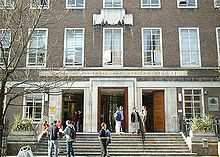
School of Oriental and African Studies
Central academic bodies
- the University of London Institute in Paris, formerly known as the British Institute in Paris
- the School of Advanced Study comprising the following institutes:
- the Institute of Advanced Legal Studies
- the Institute of Classical Studies
- the Institute of Commonwealth Studies
- the Institute of English Studies (including the Centre for Manuscript and Print Studies),
- the Institute of Historical Research
- the Institute of Latin American Studies
- the Institute of Modern Languages Research
- the Institute of Musical Research
- the Institute of Philosophy
- the Warburg Institute
- University of London International Programmes
Former colleges and schools
Some colleges and schools of the University of London have been amalgamated into larger colleges or left the University of London. These include:
- Imperial College London – became independent in July 2007[18]
- Wye College – Wye, Kent; Wye courses are now run by the University of Kent in partnership with Imperial College London, and graduating students receive a University of Kent degree and an Imperial Associateship of Wye College[19]
- Royal Postgraduate Medical School; now part of the Imperial College School of Medicine
Royal Holloway, University of London
- Bedford College – Inner Circle Regent's Park; now part of Royal Holloway and Bedford New College (the registered Royal Charter title of Royal Holloway, University of London)
- Chelsea College – Manresa Road, Chelsea; now part of King's College
- Queen Elizabeth College – Campden Hill Road, Kensington; now part of King's College
- St Thomas's Hospital Medical School; now part of King's College School of Medicine and Dentistry
- The School of Pharmacy, University of London; merged with UCL on 1 January 2012
- School of Slavonic and East European Studies although formerly an Institute of the University of London, rather than a college, is now part of University College London
- Institute of Education; merged with UCL on 2 December 2014
Queen Mary, University of London
- Westfield College – Kidderpore Avenue, Hampstead; now part of Queen Mary and Westfield College (the registered Royal Charter title of Queen Mary, University of London)
Others
- The Lister Institute of Preventive Medicine, Chelsea, London founded 1891. In 1978 became a science funding body
- New College London, was closed in 1980. Despite the name the college never had any association with Royal Holloway and Bedford New College.
- Regent's Park College moved to Oxford in 1927, becoming a Permanent Private Hall of the University of Oxford from 1957
- University Marine Biological Station, Millport, closed in 2013, now run by Field Studies Council
- University College Hull opened in 1927 as an external college, until gaining its Royal Charter in 1954 and becoming the independent University of Hull.[20]
University colleges in the International degree programme
A number of major universities originated as university colleges teaching the degrees of the University of London International Programmes. After developing the ability to function fully, these colleges became able to award their own degrees.
- Ceylon University College, established by the Ceylon University Ordinance Act in 1942 as the University of Ceylon.
- University College Nottingham, awarded a Royal Charter in 1948 as the University of Nottingham.
- University College Southampton, awarded a Royal Charter in 1952 as the University of Southampton.
- University College Leicester, awarded a Royal Charter in 1957 as the University of Leicester.
A number of other colleges had degrees validated and awarded by the University of London.[21]
- St. Patrick's, Carlow College, Ireland – from 1840 to 1892 students studied for primary degrees in Arts (BA) and Law(BLL).[22]
- St. Patrick's College, Thurles, Ireland – from 1849 the University of London, allowed Thurles to offer degrees.[23]
- Huddersfield College
- Mason Science College (which later became the University of Birmingham)
- Queen's College, Birmingham[24]
- Stonyhurst College, a Catholic college in Lancashire.
- Wesleyan Collegiate Institution, Taunton, which became Queen's College, Taunton.
- Ceylon Technical College, 1933 – 1950 students studied for engineering degrees in BSc in Engineering.
- University College Lahore
- Podar World College
- Northwest College for Advanced Learning, New Delhi, India
Colleges in special relation
Between 1946 and 1970, the university entered into 'schemes of special relation' with university colleges in the Commonwealth of Nations. These schemes encouraged the development of independent universities by offering a relationship with the University of London. University colleges in these countries were granted a Royal Charter. An Academic Board of the university college negotiated with the University of London over the entrance requirements for the admission of students, syllabuses, examination procedures and other academic matters. During the period of the special relationship, graduates of the colleges were awarded University of London degrees.
Some of the colleges which were in special relation are listed below, along with the year in which their special relation was established.
- 1946 – The University College of the West Indies, until 1961. (Now the University of the West Indies)[25]
- 1948 – University College, Ibadan, until 1967. (Now the University of Ibadan)[26]
- 1956 – University College of Rhodesia and Nyasaland (now the University of Zimbabwe).
- 1961 – Royal College Nairobi (now the University of Nairobi).
- 1963 – University of East Africa
In 1970, the 'Schemes of Special Relation' were phased out.
Coat of arms
The University of London first received a grant of arms in April 1838.[27] The arms depict a cross of St George upon which there is a Tudor rose surrounded by detailing and surmounted by a crown. Above all of this there is a blue field with an open book upon it.
In terms of heraldry the arms would be described as:
Argent, the Cross of St George, thereon the Union Rose irradiated and ensigned with the Imperial Crown proper, a Chief Azure, thereon an open Book also proper, Clasps gold
Academic dress
The University of London had established a rudimentary code for academic dress by 1844. The university was the first to devise a system of academic dress based on faculty colours, an innovation that was subsequently followed by most other universities.
Since their being granted autonomous degree awarding powers, the Institute of Education, King's College London, The London School of Economics and Political Science and University College London have each introduced their own form of academic dress. Queen Mary, University of London will, as of 2014, introduce its own form of academic dress to reflect its autonomous degree awarding powers.[28] The remaining colleges of the university continue to use the University of London academic dress.
Student life

Some 135,090 students (approximately 5% of all UK students) attend one of the University of London's affiliated schools. Additionally, over 45,000 students follow the University of London International Programmes.[2]
The ULU building on Malet Street (close to Senate House) is home to the University of London Union, which acts as the student union for all University of London students alongside the individual college and institution unions. As well as representing students, the union plays host to a number of shops and bars (including a nightclub and live music venue), owns London Student (the largest student newspaper in Europe)[29] and offers its own gym and swimming pool for student use.
Sports, clubs and traditions
Though most sports teams are organised at the college level, ULU does run a number of sports clubs of its own, some of which (for example the basketball team) compete in BUCS leagues. The union also organises its own leagues for college teams to participate in. These leagues and sports clubs are supported by Friends of University of London Sport which aims to promote them.
In addition to these, ULU caters for sports not covered by the individual colleges through clubs such as the University of London Union Lifesaving Club, which helps students gain awards and learn new skills in lifesaving as well as sending teams to compete throughout the country in the BULSCA league.
The Universities Ice Hockey squad, The ULU Dragons, have been successful in the British Universities Ice Hockey Association Division 1 and Division 2. The Dragons have also previously competed in tournaments including professional teams and have come away with several gold and silver medals from these events.
ULU also organises a number of societies, ranging from Ballroom and Latin American Dance to Shaolin Kung Fu, and from the University of London Big Band to the Breakdancing Society. Affiliated to the University is the University of London Society of Change Ringers, a society for bellringers at all London universities.
The university runs the famous University of London Boat Club, which is considered along with the Oxford University Boat Club and the Cambridge University Boat Club to be one of the three best university rowing clubs in the country.
The university also has a representative football team, which dates back to 1913 and is a collection of the best players from the various colleges. The team plays games against sides such as Cambridge's and Oxford's 'Blues' sides as well as the R.A.F, Navy and Army. Currently the team has use of both Motspur Park Athletics Stadium (Fulham F.C.'s training ground, and a former University of London property) and the Honourable Artillery Company's grounds for training and home match purposes. Former players and managers of the team include Bobby Robson and Jimmy Hill.
University of London Orienteering Club is an umbrella club for all University of London orienteering groups. Members participate in orienteering events across the UK, and occasionally further afield. In 1997, the club sent a team to participate in the US championships in Colorado.
The University of London Symphony Orchestra (ULSO) is a leading student orchestra within the UK. It comprises approximately 70 – 100 students from the University of London annually and welcomes world-renowned conductors and soloists. ULSO dates back to 1955 is well known for performing some of the most challenging works in the repertoire. The orchestra has played in some of London's foremost concert halls including Cadogan Hall, St. John's Smith Square, Duke's Hall and has been on tour in Hong Kong and Italy in recent years.
Student housing

The university operates the following eight intercollegiate halls of residence, which accommodate students from most of its colleges and institutions:[30]
- College Hall, Malet Street, WC1[31]
- Connaught Hall, Tavistock Square, WC1[32]
- International Hall, Brunswick Square, WC1[33]
- Lillian Penson Hall, Talbot Square, W2[34] (postgraduate students only)
- Nutford House, Brown Street, W1[35]
The Garden Halls
- Canterbury Hall, Cartwright Gardens, WC1[36]
- Commonwealth Hall, Cartwright Gardens, WC1[36] (paired with Hughes-Parry Hall for administration)
- Hughes Parry Hall, Cartwright Gardens, WC1[36] (paired with Canterbury Hall for administration)
Notable people
Notable alumni, faculty and staff
A large number of famous individuals have passed through the University of London, either as staff or students, including at least 4 monarchs, 52 presidents or prime ministers, 74 Nobel laureates, 6 Grammy winners, 2 Oscar winners and 3 Olympic gold medalists.
Staff and students of the university, past and present, have contributed to a number of important scientific advances, including the discovery of vaccines by Edward Jenner and Henry Gray (author of Gray's Anatomy). Additional vital progress was made by University of London people in the following fields: the discovery of the structure of DNA (Francis Crick, Maurice Wilkins and Rosalind Franklin); the invention of modern electronic computers (Tommy Flowers); the discovery of penicillin (Alexander Fleming and Ernest Chain); the development of X-Ray technology (William Henry Bragg and Charles Glover Barkla); discoveries on the mechanism of action of Interleukin 10 (Anne O'Garra); the formulation of the theory of electromagnetism (James Clerk Maxwell); the determination of the speed of light (Louis Essen); the development of antiseptics (Joseph Lister); the development of fibre optics (Charles K. Kao); and the invention of the telephone (Alexander Graham Bell). Notable political figures who have passed through the University of London include Muhammad Haji Ibrahim Egal, Romano Prodi, Junichiro Koizumi, Aung San Suu Kyi, Archbishop Desmond Tutu, Taro Aso, Walter Rodney, Nelson Mandela, John F. Kennedy, Dr. B. R. Ambedkar and Mahatma Gandhi.
In the arts field the university has produced the novelists Malcolm Bradbury, G. K. Chesterton, H. G. Wells, Thomas Hardy, Arthur C. Clarke, J.G. Ballard and the poet John Keats. Many artists have been associated with the university, including Jonathan Myles-Lea, and several of the leading figures in the Young British Artists movement (including Ian Davenport, Tracey Emin and Damien Hirst). Outstanding musicians across a wide range include the conductor Sir Simon Rattle, the soprano Felicity Lott and both members of Gilbert and Sullivan to Mick Jagger, Elton John, Dido, and members of the bands Coldplay, Suede, The Velvet Underground, Blur, Iron Maiden, Placebo, The Libertines, Queen, and Hong Kong singer-actress Karen Mok.
The University of London has also played host to film directors (Christopher Nolan, Derek Jarman), philosophers (Karl Popper, Roger Scruton), explorers (David Livingstone), international academics (Sam Karunaratne), and leading businessmen (Michael Cowpland, George Soros).
Chancellors
The Chancellors of the University of London since its founding are as follows:
- William Cavendish, 2nd Earl of Burlington 1836–1856
- Granville Leveson-Gower, 2nd Earl Granville 1856–1891
- Edward Stanley, 15th Earl of Derby 1891–1893
- Farrer Herschell, 1st Baron Herschell 1893–1899
- John Wodehouse, 1st Earl of Kimberley 1899–1902
- Archibald Primrose, 5th Earl of Rosebery 1902–1929
- William Lygon, 7th Earl Beauchamp 1929–1931
- Alexander Cambridge, 1st Earl of Athlone 1932–1955
- Queen Elizabeth The Queen Mother 1955–1981
- The Princess Anne (The Princess Royal from 1987) 1981–present
Vice Chancellors
See also
- Golden triangle (universities)
- List of modern universities in Europe (1801–1945)
- Third oldest university in England debate
- United Hospitals
References
- ↑ Combined total of "Table 0a – All students by institution, mode of study, level of study, gender and domicile 2005/06". Higher Education Statistics Agency online statistics. Retrieved 2007-07-15. The individual totals are Birkbeck, University of London 19,020, Central School of Speech and Drama 950, Courtauld Institute of Art 395, Goldsmiths, University of London 7,615, Institute of Cancer Research 235, Institute of Education 7,215, King's College London 21,755, London Business School 1,455, London School of Economics 8,810, London School of Hygiene and Tropical Medicine 975, Queen Mary, University of London 11,625, Royal Academy of Music 730, Royal Holloway, University of London 7,620, Royal Veterinary College 1,610, SOAS, University of London 4,525, School of Pharmacy 1,355, St George's, University of London 3,785, University College London, Central institutes & activities 430. Heythrop College is privately funded and does not appear in HESA statistics. It gives its total number of students as 700. "Prospective Students". Heythrop College website. Retrieved 2007-07-15. Imperial College London has left the University since the year 2005–2006.
- ↑ 2.0 2.1 "About us". University of London International Programmes website. Retrieved 2007-07-15.
- ↑ "About us". University of London. 2 April 2012. Retrieved 12 July 2012.
- ↑ "University of London: Brief history". London.ac.uk. Retrieved 2010-04-13.
- ↑ Japanese Students at Cambridge University in the Meiji Era, 1868–1912: Pioneers for the Modernization of Japan, Noboru Koyama. Lulu Press, September 2004.
- ↑ "City of Sound". City of Sound. 22 November 2003. Retrieved 2010-04-13.
- ↑ Emporis GmbH. "Emporis Buildings". Emporis.com. Retrieved 2010-04-13.
- ↑ "Senate House, Bloomsbury, WC1 — The Twentieth Century Society". c20society.org.uk.
- ↑ Archives in London & the M25 area (AIM25) (29 November 2006), "Athlone Press: 1945–1979", holdings at Senate House Library, University of London, retrieved 21 December 2009
- ↑ allbusiness (29 November 2006), "Sturrock departs Continuum", Article citing companies encompassed by Continuum, retrieved 21 December 2009
- ↑ The Guardian. 18 November 2002 Opposition ends Imperial and UCL merger dream
- ↑ CBLAIR. "News_5-10-2006-13-17-17". imperial.ac.uk.
- ↑ School of Pharmacy merges with UCL. Ucl.ac.uk (1 January 2012). Retrieved on 2013-07-17.
- ↑ The Guardian, http://www.theguardian.com/education/2014/mar/24/cost-private-contracts-universities-documents-services-workers
- ↑ "The Central University's Estate". University of London. Retrieved 2007-03-02.
- ↑ "Redevelopment Project of Senate House and Stewart House". School of Advanced Study. Retrieved 2007-03-02.
- ↑ "University of London: Council membership" (PDF). Archived from the original (PDF) on 29 August 2006. Retrieved 2006-10-24.
- ↑ "University of London News: Imperial College Leaves University of London". Retrieved 2007-12-04.
- ↑ Wye college at the Wayback Machine (archived 13 June 2007)
- ↑ "University History". University of Hull. Retrieved 17 December 2014.
- ↑ N. B. Harte, The University of London, 1836–1986
- ↑ Carlow College Report HETAC
- ↑ University of London – The Illustrated London News, 11 May 1850
- ↑ A History of Birmingham, Chris Upton, 1993, ISBN 0-85033-870-0
- ↑ "University of the West Indies". Uwi.edu. 24 June 1986. Retrieved 2010-04-13.
- ↑ Archived 9 October 2006 at the Wayback Machine
- ↑ The University of London, 1836–1986 ... – Google Books. Books.google.co.uk. Retrieved 2010-04-13.
- ↑ http://www.arcs.qmul.ac.uk/students/graduation/your-degree-award/index.html?utm_source=MySIS&utm_medium=Your+degree+award&utm_campaign=re-enrolment
- ↑ BAM Agency Ltd. "London Student". Ulu.co.uk. Retrieved 2010-04-13.
- ↑ "University of London – Intercollegiate Halls". Lon.ac.uk. 26 March 2010. Retrieved 2010-04-13.
- ↑ "University of London Accommodation – College Hall". Halls.london.ac.uk. Retrieved 2010-04-13.
- ↑ "University of London Accommodation – Connaught Hall". Halls.london.ac.uk. Retrieved 2010-04-13.
- ↑ "University of London Accommodation – International Hall". Halls.london.ac.uk. Retrieved 2010-04-13.
- ↑ "University of London Accommodation – Lillian Penson Hall". Halls.london.ac.uk. Retrieved 2010-04-13.
- ↑ "University of London Accommodation – Nutford House". Halls.london.ac.uk. Retrieved 2010-04-13.
- ↑ 36.0 36.1 36.2 "University of London Accommodation – Garden Halls". Halls.london.ac.uk. Retrieved 2010-04-13.
External links
| Wikimedia Commons has media related to University of London. |
- University of London website
- University of London Archives
- University of London student lists
- The University of London Act 1994
- University of London military service,1914–1945
| ||||||||||||||||||||||||||||||||||||||||||||||||||||||||||||||||||||||||||||||||||||||||||||||||||

